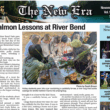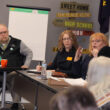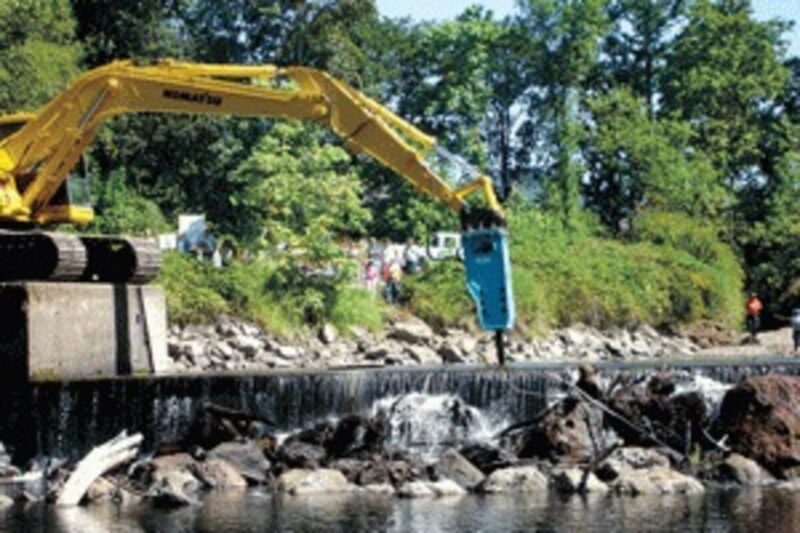Scott Swanson
Of The New Era
With the swings of a giant jackhammer, nearly 150 years of history came to an end Monday, Aug. 27, as removal of the Brownsville Dam began.
The 143-foot structure, on the Calapooia River just north of Brownsville off Northern Drive, is expected to be completely removed by the end of this week, said Bud Baumgartner of Holley, president of the Calapooia Watershed Council.
The Brownsville Dam removal is the first project to be completed under the National Oceanic and Atmospheric Administration’s new Open Rivers Initiative, which provides funding and technical expertise for community-driven, small dam and river barrier removals. Under the initiative, NOAA will work with communities to remove up to 50 obsolete dams and rundown culverts across the nation each year. These projects will begin to repair river systems and also eliminate dangerous conditions that are prevalent at outdated structures.
According to NOAA, more than 3,500 large dams in the U.S. are considered unsafe, and thousands of smaller dams are also susceptible to leaking, buckling, and failure, placing nearby communities at risk.
Baumgartner said that the dam was starting to fail before the decision was made to remove it.
“The concrete was starting to fail and there was a hole, as part of the dam was washed away,” he said.
The dam’s origins go back to 1858, when local business people built a wooden crib dam to divert water into a millrace. Over the years, Baumgartner said, the dam powered a grist mill, a flour mill, a sawmill and a woolen mill that burned down in the 1950s. He said after that there was no need for water to run the mills, but the community kept the dam in place to provide water for the canal, which runs through the heart of Brownsville. However, the dam began to disintegrate and there were times when the canal was dry, he said.
When First Lady Ladybird Johnson established the Beautify America program in the late 1960s, the community received grant money to build a concrete dam to maintain the aesthetic effect of the millrace running through town. It also created a swimming area for local residents.
The concrete dam stood between 5 and 8 feet high, with a system of flashboards on top that were installed during summers to add another 5 feet, which diverted water into the millrace.
Baumgartner said the dam caused problems for salmon and steelhead trying to return to the upper Calapooia to spawn.
“When the dam was constructed, there was very little concern for fish,” he said. “The assumption was that fish could jump over the 5-foot structure.”
As it turned out, he said, that wasn’t necessarily the case. Fish did make it through, but when the river was high, the volume coming over the dam forced steelhead to pool until conditions were right for them to make the leap. In the summer the boards were up when the spring Chinook were moving up the river. Karen Hans, an Oregon Department of Fish and Wildlife biologist who has been involved in the dam project, said that a “fish ladder,” which was more of a channel carved into the bedrock in the riverbank, proved short and steep, which made for difficult passage. It was worse for fish when the boards weren’t diverting water into the canal.
“Fish migrating through May and June, with the dam boards not in place, had a really hard time getting through there,” she said.
Winter steelhead, which migrate and spawn from November through April, had less problems because more water was flowing over the dam during that period of the year, she said.
The dam and canal are owned by the Brownsville Canal Co., an organization of homeowners whose land fronts the canal. Baumgartner said the organization was low on funds for maintaining the dam and had trouble paying for liability insurance.
So, he said, when the decision was made, after about five years of community discussion, to remove the dam, there was a lot of interest from government agencies such as NOAA, the U.S. Army Corps of Engineers, the Department of Environmental Quality, the Oregon Watershed Enhancement Board and others, some of whom helped fund the $820,000 project. Most of the money will come from the state lottery-funded OWEB.
“That’s why we were able to get approval of the grant funding,” Baumgartner said. “You can’t believe the complexity of getting the approval. It’s been a very good process because we had support from all the agencies.”
The dam removal will make 40 miles of spawning stream more accessible, he said.
“All of the biologists are all very positive about this thing,” Baumgartner said. “All the salmon and steelhead habitat is upstream from this thing. It’s a barrier to fish passing.
“The fish had been getting there, but they had some problems along the way.”
Hans said that she believes the spring Chinook salmon will benefit the most from the change.
She said that ODFW employees do annual snorkel surveys in the upper Calapooia, looking for adults that have moved up the river in May and June and are holding there, waiting to spawn in September. The high they’ve counted was 66 in 2001, while 30 has been the average. But in the last couple of years, she said, “we haven’t seen hardly any. We only saw one this year.”
The removal of the dam doesn’t completely solve the problems facing migrating fish. The Sodom Dam, along the Sodom Ditch near Halsey, also poses a barrier to fish, Hans said.
“I’ve seen Chinook and steelhead backed up behind that dam, trying to get over,” she said. The dam is scheduled to be replaced in 2009 with a structure that will include an improved fish ladder.
ODFW’s goal, she said, is to re-establish the population of steelhead and salmon in the upper Calapooia. One problem is that there is little data on what the original numbers looked like. Experts say the upper watershed is capable of supporting upwards of 1,100 steelhead and 650 Chinook, but Hans said officials have no idea of what the actual numbers have been in the past.
“It’s always a challenge we face in trying to recover these fish in that we don’t have a lot of historical information,” she said. “What was it like when Lewis and Clark were here? Early settlers probably didn’t know the difference between steelhead and salmon. They didn’t do research counts.”
She said ODFW officials, along with representatives of Weyerhaeuser and the Calapooia Watershed Council, are discussing releasing both juvenile and adult fish in the upper Calapooia to help them determine what the obstacles are to the fishes’ recovery.
“Is it summer habitat for adults? Winter habitat for juveniles? We’re looking at increasing research to find out what the problems are so we can concentrate our efforts in the right place,” she said.
“We want to be able to recover the Chinook and steelhead to the point that we can allow fishing (beyond catch-and-release).”





